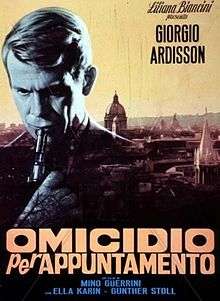Omicidio per appuntamento
| Omicidio per appuntamento | |
|---|---|
 | |
| Directed by | Mino Guerrini |
| Produced by | Giuliano Simonetti[1] |
| Starring | |
| Music by | Ivan Vandor |
| Cinematography | Franco Delli Colli |
| Edited by | Franco Fraticelli |
Release dates | 1966 |
Running time | 1:45:00[2] |
| Country |
Italy West Germany |
| Language | Italian |
Omicidio per appuntamento is a 1966 giallo film directed by Mino Guerrini. The film stars George Ardisson, Günther Stoll and Ella Karin. The film has been described as "stylish" and "flamboyant", and has been seen as inspired by the work of Mario Bava.
Omicidio per appuntamento depicts the investigation of a disappearance by Vince Dreyser (Ardisson), a private detective in Rome who is searching for a vanished friend. Dreyser's investigation leads him into the city's criminal underworld.
Plot
Vince Dreyser (George Ardisson), an American private detective working in Rome, meets with his old friend Walter Dempsey (Hans von Borsody) in the countryside. Several days later, Dempsey has vanished under suspicious circumstances, leading Dreyser to investigate the disappearance. Dempsey was in the country to be married, and the search for his whereabouts leads Dreyser into a web of organised crime, while trying to keep an eye on the daughter of a wealthy client.
Cast
- George Ardisson - Vince Dreyser
- Günther Stoll - Commissioner Silvio Giunta
- Ella Karin - Fidelia Forrester
- Hans von Borsody - Walter Dempsey
- Mario Brega - Mario Galante
Production
Omicidio per appuntamento was directed by Mino Guerrini. Guerrini had previously worked as a script supervisor on the film La ragazza che sapeva troppo,[3] which has been described as the first giallo film.[4] Actors Giorgio Ardisson and Graziella Granata—credited as George Ardisson and Ella Karin respectively[5][6]—had previously appeared together in the horror film I lunghi capelli della morte, with Karin credited as Halina Zelewska.[7]
Release and reception
Omicidio per appuntamento was released in 1966, and was also distributed under the title Agent 3S3 setzt alles auf eine Karte.[8]
Writing for AllMovie, Robert Firsching has described the film as "stylish" and "flamboyant", finding Guerrini's direction to have been influenced by the works of fellow countryman and giallo "pioneer" Mario Bava.[2]
Footnotes
- ↑ "BFI | Film & TV Database | Omicidio per appuntamento | Full Credits". British Film Institute. Retrieved October 30, 2012.
- 1 2 Firsching, Robert. "Omicidio per Appuntamento – Cast, Reviews, Summary, and Awards". AllMovie. AllRovi. Retrieved October 30, 2012.
- ↑ "Mino Guerrini – Movie and Film Biography and Filmography". AllMovie. AllRovi. Retrieved October 30, 2012.
- ↑ Firsching, Robert. "The Girl Who Knew Too Much – Cast, Reviews, Summary, and Awards". AllMovie. AllRovi. Retrieved October 30, 2012.
- ↑ Chiti, Lancia & Poppi 2003, pp. 30–31.
- ↑ Lancia 2003, p. 173.
- ↑ "BFI | Film & TV Database | I lunghi capelli della morte | Full Cast". British Film Institute. Retrieved October 31, 2012.
- ↑ "BFI | Film & TV Database | Omicidio per appuntamento (1966)". British Film Institute. Retrieved October 30, 2012.
References
- Chiti, Roberto; Lancia, Enrico; Poppi, Roberto (2003). Dizionario del cinema Italianio: Gli attori, A–L. Gremese Editore. ISBN 8884402131.
- Lancia, Enrico (2003). Dizionario del cinema Italianio: Le attrici, dal 1930 ai giorni nostri. Gremese Editore. ISBN 888440214X.
External links
- Omicidio per appuntamento at the Internet Movie Database
- Omicidio per appuntamento at Rotten Tomatoes